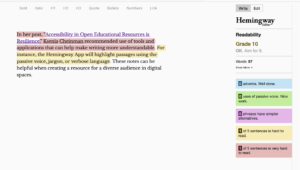Case Study 7.2: Hemingway App—An Author Workflow
In her post about OER accessibility, Ksenia Cheinmann encouraged authors to take accessibility into account in not only the structure of their documents but also the clarity of their writing. She pointed out how clear writing is good for everyone including people with learning and print disabilities. Clear writing stays away from the passive voice, from jargon, and complex phrasing.
One tool that can help authors streamline their writing is the Hemingway App, as Cheinmann demonstrated in her post. The Hemingway App has a free web tool that will mark up a passage to point out complex wording, excess use of descriptors, and convoluted phrasing. The following is an example from the web application.

The Purdue OWL suggests another editing technique called the paramedic method that may prove helpful when streamlining a piece of writing. The paramedic method includes the following steps:
- Circle the prepositions in a passage of writing. Prepositions often show up in the passive voice or passages with indirect phrasing.
- Draw a box around the “is/are” verb forms in the passage.
- Ask, “where is the action?” in this sentence.
- Wherever possible, replace “is/are” verbs with active verbs.
- Move the “doer” of an action to become the subject of the sentence;
- Eliminate slow wind-ups.
- Eliminate any redundancies.
For more about clarity in writing, see the following sources:
